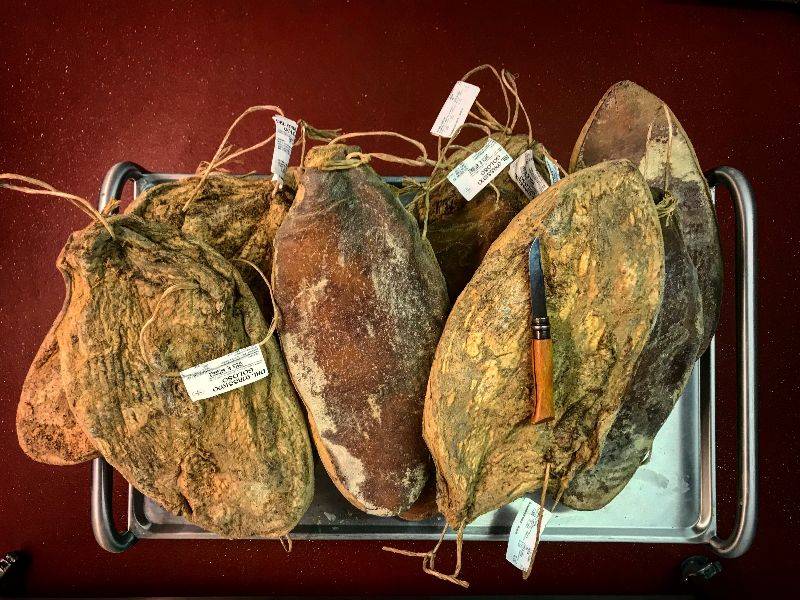THERE are some questions which stay questions. And at our Saturday counter, one of the questions which we hear asked more than most is about nitrates and nitrites.

Nitrates and Nitrites: The Low Down
N Words: Nitrates & Nitrites
Firstly, with one exception, when our producers use nitrates or nitrites, it’s the former. Nitrates, saltpetre, salt of stone, Chinese snow, salt from Chinese salt marshes, this naturally occurring impurity has as many historic and culturally-specific different names as it has uses, of which preservation is just one. Nitrates are formed when organic matter nitrifies on contact with air, moisture and alkaline soils, dissolves in rainwater and then evaporates, leaving behind a crystalline, salty sediment that looks like white powder. They have been used to preserve, to make war, to thicken african stews and soups, to make a kind of glutinous porridge, even (with highly toxic results) as a coolant for wine (the Romans used it as a kind of ice) for millennia.
In the specific history of curing then, nitrates or saltpetre would have been first used by accident, as a mineral impurity present in some sources of the rock, sea and vegetable salts used to cure meat. Where it was present, humans would have begun to observe different results - because nitrates contribute their own distinctive, piquant flavour (the flavour we have come to associated with ‘cured’) and also, by preventing fat oxidation, both sharpen colour and guard against rancid flavours. Today, we know nitrates have greater efficacy than salt in suppressing pathogens, and namely the clostridium botulinum microbe which causes botulism. They do so by converting to nitrites which are the active, preventative ingredient, acting as a slow-release reservoir for continuous nitrite supply to the meat over the course of its long ageing time.
Over the cure those nitrites then in turn deplete, and final nitrate and nitrite presence is measured in the level of residual nitrites. Done properly - i.e when the meat is aged for long enough - nitrates should have been entirely converted and nitrites depleted to tiny residual levels. In today’s more commercial production, pure nitrites are now often added instead of traditional nitrates, to accelerate the speed of curing. Nitrites work on the meat immediately (rather than that slow nitrate > nitrite conversion). We are more wary of nitrites in salumi as they’re often a warning flag to more industrial, potentially aggressive production more concerned to speed up, rather than slow down.
Not all salumi producers who use nitrites are cutting corners. But modern nitrite use has gone hand in hand not only with accelerated curing but with use of inferior quality raw materials which, without preservative, would be very risky. When used in these contexts, where nitrite is not about support for traditional ageing process, but can be about concealment and deception (disguising poor quality meat with seductive red colour for example) it is reasonable to suspect that nitrites are used at higher levels.
|
Unlike North Italy, South Italy, with its different climate (one could argue better for curing) has no tradition of using preservatives. Our 'nduja from Calabria is preserved with salt only.
|
Why does all this matter? Because research has shown us that nitrates and nitrites do have the potential to do us harm. Nitrites are precursors to the cancer-linked nitrosamines which form through a reaction that can take place in our digestive systems, in our frying pans, through storage or in the actual processing and ageing of the meat. There is a lot more research to be done on this, as it appears different meat types, meat compositions, processing and storage methods can all affect the behaviour of nitrates and nitrites in meat and their likelihood of forming nitrosamines.
Until there is more research out there, full transparency on the levels of nitrates or nitrites that go into our meat and the residual levels in the final product seem to be the most useful knowledge we have. Because, although the Italian government sets a legal ceiling for nitrite presence (150mg/kg) in cured meats, there’s a lot of variation within that - we’d argue an aggressively cured, industrial meat is more likely to contain higher levels.
We can help with the full transparency. With questions like these, it feels very precious to know as comprehensively as possible how our food is produced. We can speak to Chiara and Mauro Luiset say, who do use the traditional, typical nitrate cure for their salamis, and know exactly how much is going in. And we can let you know our latest test results on residual nitrates in their salamis and ham. We can tell you that Mauro puts in 8mg of nitrate for 1kilo of meat and that <8mg remain at the end (this is the limit of our testing sensitivity). If we’re going to keep eating cured meats, which certainly for us is a yes we’d prefer to eat the cured meats we know, rather than an anonymous package at the supermarket.
But what about the curing without nitrates? Our producers who cure with nitrates do so as part of a passionate, and ancient tradition of handing recipes down through families and to remove nitrates would also be, undoubtedly, to lose the character of that recipe. Using nitrates is a way of not just preserving, but of holding on to ancient tradition and as above, for our producers, it is about flavour and texture as much as it is safety. So it’s an emotive topic and we don’t necessarily have the answer. What we can say, however, is that nitrates aren’t everyone’s tradition, and if you’d prefer zero nitrates we can point you to producers who use just a plain salt cure. They’re not so numerous, but they’re there.

